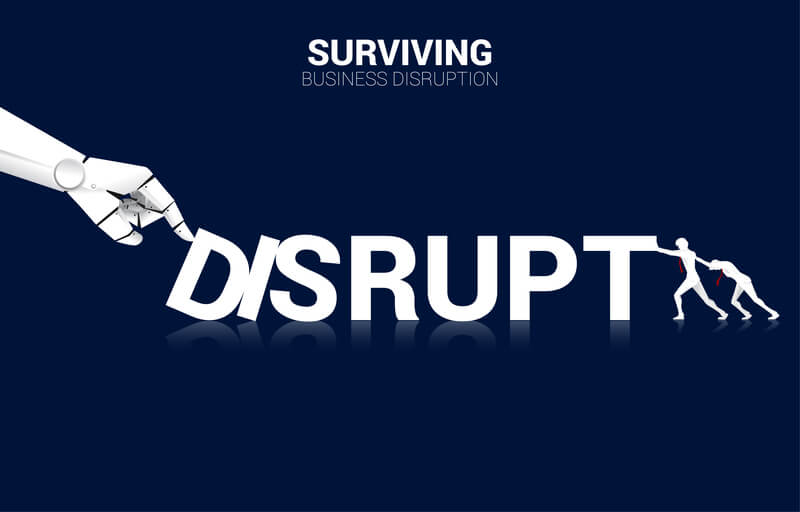
How can we change the way we see “disruption”?
Do Love it or hate it, one of the most ubiquitous terms in modern times is “disruption”. The term “disruptive technology” originated from seminal research by the late Harvard Business School Professor Clayton Christensen, who was asking the question, “why do big, successful, well-managed companies end up being displaced by upstart entrants?” His theory became popularized in his book The Innovator’s Dilemma and subsequent works.
Professor Christensen had a very specific conceptualisation of disruption, where innovations – technological, business models – that are initially ignored by established players because they are seemingly unattractive, eventually gain traction to displace them.
Today, terms such as “disruption”, “disruptive innovation” or “digital disruption” seem to be applied liberally – every industry seems to be facing disruption, every company needs to “disrupt or be disrupted”, and every startup wants to disrupt industry X. The Professor also often lamented how the term had become conflated. An influential concept no doubt, but by being applied to everything, is it in danger of not meaning anything? So how should we think about “disruption”?
In this article, I posit that the concept has a lot of value and will present a perspective on how to think about it.

Identify customer needs and how novel combinations of new innovations and established capabilities can serve these needs.
Disruption - Changing Basis of Competitive Advantage
I offer a simplified view of disruption – when innovations emerge that change the established basis of competitive advantage. Every industry has some shared understanding of what it takes to be successful. In management research, this is called strategic schemas or dominant logic, which includes assumptions or beliefs about factors like customer preferences, competitive boundaries, what constitutes strategic assets, etc. Disruption renders these schemas obsolete, often technologically-driven, but also (and usually combined with) other trends such as social or consumer behaviour shifts, regulation and policy, and of course systemic shocks like COVID-19.
So, what does this actually mean? Let’s see how this applies to an often-cited exemplar of disruption – Netflix’s dethroning of Blockbuster Video. Back in the day, when watching movies at home involved physically going to the store to rent a video, a key aspect of competitive advantage was having a wide network of retail stores in prime locations, something Blockbuster did very well. However, in the Netflix world of Internet distribution – first mail orders from their website, and later streaming directly to your home, how valuable is all that retail real estate? Internet-based digital customer acquisition and distribution had rendered the old model obsolete.
We can consider other sectors. E.g., in the Airbnb world, are physical hotel assets as valuable as they used to be? Or in the world of E-commerce or digital finance, are the physical retail stores or bank branches that used to serve businesses still relevant? We will come back to this shortly, in the meantime, consider what your answer may be.
“Established companies are not disrupted by upstart “disruptors”, they disrupt themselves, by failing to adapt, and often, sticking with bad business models.”

If your business fails to adapt to shifting trends, there will be opportunities for someone to steal your pie.
Companies Struggle with Disruption Because Deep Assumptions Are Hard to Change
In my time working with, researching, and advising companies on areas like digital transformation, I have noticed a common trend. Established companies are not disrupted by upstart “disruptors”, they disrupt themselves, by failing to adapt, and often, sticking with bad business models. It is never just a lack of capabilities, technology, or knowledge – these can be acquired. It is the mindset, grounded in deep-seated assumptions that are hard to change because they are often taken for granted, and frequently reinforced by structural factors.
Blockbuster’s case gives us many illustrative examples. For instance, one of the reasons why customers flocked to Netflix was because a big part of Blockbuster’s revenue involved punitive actions against their customers. Return your video late? Pay a late fee. Forgot to rewind your video cassette? There is a fee for that too. Netflix came along and did away with these practices. Why was it so hard for Blockbuster to change this? Well, late fees amounted to $300mil in annual revenue.
Another famous story was how Blockbuster turned down the opportunity to buy Netflix for $50 million (today Netflix is worth $236 billion), often cited as an epitome of incumbent myopia. But the details of the story offer some interesting nuances. In 2007, to compete against Netflix, Blockbuster launched its own streaming service called Total Access. Netflix’ CEO Reed Hasting was so concerned about the threat that they approached Blockbuster with the offer. However, strategic shifts require investment and profitability hits for the already floundering company, and an activist investor put a stop to the program by firing CEO John Antioco.
Could Blockbuster had succeeded with Total Access? It is hard to predict how things may have turned out differently. But this story does reveal many of the barriers that companies face in navigating disruptive transformations, and how everyone needs to be on board.
Also, if your business model involves poor customer experiences, profiting from customer detriment, or generally fails to adapt to shifting trends, your business is a ticking time bomb. New technologies create opportunities for someone else to come and steal your pie.

Not all customer needs can be met purely online, and physical retail assets can be valuable, but only if re-imagined as part of a redesigned omnichannel offering.
Disruption Does Not Mean Incumbents Need to Die; It Just Means Systemic Change
There is a popular trope that established companies are destined to be disrupted by entrants with flashy new tech or business models. New entrants into an industry do have the real advantage of being unencumbered by legacy assumptions that plague incumbents.
Yet, we are seeing many cases of big, “legacy” companies gaining ground. In the US, while Amazon has no doubt been the market leader in e-commerce, retail giants like Walmart and Target have been very successful in their digital retail transformations. In the online streaming wars, Disney Plus is giving Netflix a run for its money. In big finance, firms like Goldman Sachs and JP Morgan are venturing into retail banking, including partnerships with Fintechs and big tech (eg. Goldman Sachs and Apple tie-up). And doing quite well so far.
A key factor to remember is that “disruption” leads to systemic shifts, e.g. in technology, consumer behaviour, etc. But the outcomes are often less “disruptive” as initially envisioned. Consider our earlier question – do physical retail stores matter in the digital world? Retail in the new world is actually converging not purely online, but more “phygital”, a combination of physical and digital. Not all customer needs can be met purely online, and physical retail assets can be valuable, but only if re-imagined as part of a redesigned omnichannel offering, for example as experiential centres (e.g. Decathalon), enabling Buy online, pick-up in-store (BOPIS) operations, as customer engagement channels, as part of reverse logistics for circular business models etc.
Even retail “disruptors” have realised the value of physical retail. For example, Made.com and Wayfair are moving away from pureplay e-commerce and investing in physical retail stores, not as your conventional furniture store, but as showroom centres for customers to experience their products, that they can then purchase online.
“In the face of “disruption”, the job for everyone – established companies AND entrants – is to spot how the world is shifting and envision new ways of meeting customer needs.”
In the face of “disruption”, the job for everyone – established companies AND entrants – is to spot how the world is shifting and envision new ways of meeting customer needs. Remember, as an established company, your biggest disruptive threat is not the next startup, it is yourself.

Make strategic bets; disruptive innovations may not seem attractive at first but inaction might lead to being left behind.
Here are some things for business leaders to consider:
- Constantly forward scan and keep a handle on how customers and markets are shifting. What generational shifts are pertinent, how does the next generation of consumers buy, interact, and live? For example, will everyone still want to own cars?
- Periodically question and challenge your deep-rooted assumptions. What underlying beliefs and assumptions underpin your theory of competitive advantage? Do they still apply in this coming world?
- Focus on customer and market needs. Not just what they say on the surface, but what are their underlying, often unspoken needs, how are they shifting? For instance, customers do not want a “housing loan”, they want to have a nice home for their family. In what ways can you meet that need? What other needs are part of that journey can you offer?
- Consider how novel combinations of new innovations and established capabilities can serve these needs. Don’t just “apply”, but reimagine from first principles
- The time to invest in new innovations is when the business is healthy, not when it is floundering and attacked from all sides. Make strategic bets early. Disruptive innovations may not seem attractive at first (and some may not take off), but you also do not want to be left behind. We can see this in the electric vehicle and solar markets and how rapidly technology has developed.
- Policy and regulatory environments can be enabling for “positive” disruption. For instance, one of the reasons the UK has a thriving Fintech scene, aside from technological shifts, is forward-thinking regulation and policy.
About the Author

Samsurin advises business leaders on strategy, digital transformation, and sustainability and circularity strategies. He is the co-founder and Chief Technology Officer of Hyve Market and is also completing his PhD at the University of Cambridge, researching how emerging technologies such as AI and blockchain impact industries and society. He formerly held senior leadership roles in digital innovation and IT strategy for the national oil & gas corporation of Malaysia.





